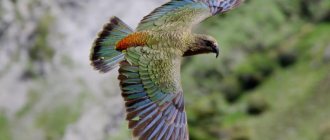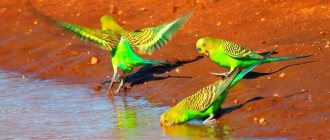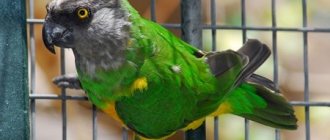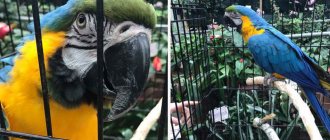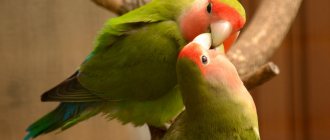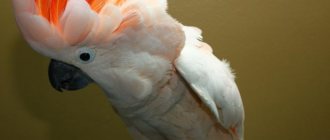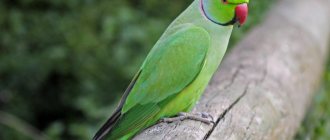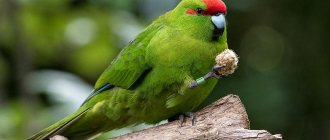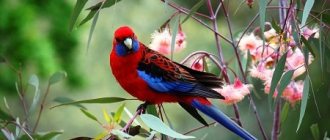Today parrots can be found in all corners of our planet. They say that Australia is the “father’s home” for all species, although these birds are common on all continents, not counting Antarctica and Europe. Traveling through South and Central America, India, Southeast Asia, West Africa and Australia, you have the opportunity to see how incredibly beautiful and intelligent parrots can be. But, of course, in order to admire birds in their natural habitat, you don’t have to pack your bags - thanks to technological progress, every person has the opportunity to plunge into the world of parrots.
Parrots prefer to live in subtropical and tropical climates, so the Southern Hemisphere is the optimal region for the life of these birds:
As the map transitions from lighter to darker shades, we can conclude that the greatest diversity of parrot species is found in South America and Australia:
More than 370 species of these stunning birds live around the world.
Where parrots live according to their families can be clearly shown by a world map with indicators of specific bird species:
Basically, parrots live in flocks and groups; by their nature, they are monogamous birds, which, when favorable conditions arise, unite in pairs, create housing using the hollows of eucalyptus trees, digging holes or inhabiting rock crevices. Birds manage to raise a new generation of parrots as soon as the weather allows them to engage in carefree mating games and adequate nutrition for the whole family.
Where do parrots live and what do they eat in the wild?
It is known that in nature parrots live near the equator and in southern latitudes. Exotic birds love warmth and sunlight, so they prefer subtropical and tropical climates. There are 350 species of parrots, all of which inhabit the southern part of the globe: Australia, Latin America, Africa and South Asia. Let's look at several species, their habitats and life characteristics. Let's start with the most prominent representatives of the avian elite - macaques.
This spectacular colorful parrot is native to the continent of South America. Each species of the macaw genus lives in different climatic zones: one chooses dense tropics, another chooses savannas, and the third is found in mountainous regions. Living conditions in certain parts of the continent are radically different: the humid jungle of the Amazon, the dry Brazilian savannah, the mountain peaks of Peru with thin air. Parrots living in a certain area adapt to their environment. Macaws especially appreciate the presence of tall trees - they spend most of their time there without looking for food.
In Latin America it is warm all year round and there is no shortage of food. The harvest is always ripening, and there is always some kind of food on the menu. What do these parrots eat in the wild? Macaws are herbivorous birds that can feed on any edible plant:
You know that? The poppy pie's favorite delicacy is juicy fruits, from which it tears out the seeds with its beak and throws the torn pulp onto the ground.
Budgerigars
Small representatives of the family, budgerigars, can be found in nature on the smallest continent. Australia is their habitat. Only in this region do huge noisy herds of feathered nomads live and breed. They roam all over the earth, staying in one place as long as there is food and water there. Dry periods alternate with rainy seasons, but such harsh conditions do not deter the resilient birds.
In the immediate vicinity of water bodies you can find flocks of green budgies, which practically disappear during drought. Wiggers suffer from lack of water and food, but due to hunger they visit farmland. These birds feed on grass seeds, which they can swallow whole. They eat fruits and soft nuts. They eat small meals throughout the day because their metabolism is fast and they need a lot of energy to move.
Lovebirds
So, we talked about where tiny budgies live. Now it's the lovers' turn. The African tropics and the island of Madagascar are the home of these birds. They form herds and stay near water bodies. They can fly well, run fast and move deftly through trees by grabbing a branch with their beak. They feed on plants: seeds, shoots and buds. They nibble on grass and nibble on fruits and berries. Don't underestimate insects.
Important: love birds are very smart and careful. They have a very high instinct of self-preservation. They will never try suspicious fruits of unusual color and shape.
The gray jack parrot lives in West Africa (Congo, Guinea, Angola). He chooses mangroves, forest thickets. He doesn't like open spaces. It is difficult and awkward for him on the ground, but in the air he feels quite confident. Tall trees with a dense crown are suitable for him to spend the night. These birds nest in tree trunks, where they carry weapons and raise young ones.
Jacko is a medium sized parrot. One day he eats up to 100 g of food. In times of famine, the family community settles into the grain fields, destroying the crops. The powerful beak can easily chriring hard shells of nuts and crushed juicy fruits. An impressive part of the diet of wild parrots is the fruit of the palm of oil.
The tree parrot is a cheerful and ornate bird. It lives in the Philippines and Indonesia, in North-Eastern Australia, where eucalyptus trees dominate. Gathering in a small family, Czajka sat on forest scrubs, nesting in tree holes. The bright colors do not interfere with the parrots' camouflage patterns in flowers and leaves.
Lory parrots spend a lot of time feeding due to their diet. Strikingly different from what other family members usually eat. This is soft food: resins, fruit juices, nectar, pollen. Movement between thriving plants, they drink nectar and thus contribute to pollination. 5,000 flower species provide food for small birds.
Long-billed Emerald Parrot
This feathered bird is nicknamed rock parrots due to their habitat. The only area where this parrot lives is the mountainous country of Chile. A flock of green birds breathes into the forested areas on the mountain slopes. Its long beak is adapted for digging up suitable food from the ground. With a beak and strong claws on its feet, the bird breaks the soil and digs up the roots and tubers of plants. Perhaps that's all the Dimmer parrot is interested in.
Kakapo
A unique parrot that lives in New Zealand. Settlement of rain forests, highlands and plateaus. Due to its weak wings, the Kakapo cannot fly, but it can climb trees well. It helps with its heavy beak and flat, wide legs. Capo jumps down, balancing with wings. During the day he hides in the feast, and at night he goes outside in search of food. The Kakapo's bow allows it to crush food, which is why this bird is characterized by its movements. In her natural kabapu environment, she feeds the plants, leaving the soil exhausted. They feed on blueberries, juice and seeds.
Parrot Kea, Alias Nestor, lives on the South Island of New Zealand. This is the only mountain parrot that is adapted to live at an altitude of 1500 meters. Not terrible difficult conditions: low temperatures, fog, snowdrops. This smart, brilliant bird keeps close to people, goes to tourist databases and at campsites.
The best place to live for a KEA is a place with trash cans. It's hard to find familiar food on snowy ground, and Nestor doesn't disdain leftovers. During periods of particularly severe hunger, Kea attacks the sheep and goes into a trance.
This is interesting! Local residents gave the parrot the nickname “sheep killer.” The bad publicity of this cunning bird has caused a long-term fattening of the population, which has led to this species being listed as endangered.
Amazon
Why was this parrot called so named? This is due to the region - these birds live in the Amazon basin. In addition, the Amazons are partially dispersed into the Antiles and a small part of Central America. The humid, hot and damp climate is not an obstacle for birds; they easily adapt to all conditions. Amazons, who do not have solitude, are characterized by joining together in a large herd. That's what they live, in groups where everyone is connected to each other. Bird's menu consists primarily of berries, buds, flowers and seeds.
Therefore, we learned that parrots live in southern countries with warm climates. The vast majority of species occur in Australia, one third in South America, and the rest in Asia and Africa. Their usual environment is deciduous forest. All parrots eat vegetables and lead a cooperative lifestyle.
Parrot - care and maintenance at home
Parrot selection
When buying a parrot, the first thing you need to pay attention to is age. Young parrots get used to new conditions more easily, are tamed faster, are most often more capable of learning, and are easier to produce offspring from.
Healthy parrots always have elastic, fast movements, plumage that fits tightly to the body, lively, shiny eyes and breathing without wheezing or whistling sounds. It is not recommended to buy parrots that have noticeable violations of these signs. Also avoid buying a parrot with bare areas, this means that the parrot has a tendency to pluck itself.
Transporting a parrot
To transport parrots over a short distance, a special transport cage is required. The size of the transport cage depends on the distance over which the parrot is transported and its size.
If transportation will last more than 3 hours, then a feeder and an automatic drinker must be placed in the cage. When transporting a parrot for more than 2 days, the transport cage should be of a size familiar to the parrot, as if it were living at home.
Parrot cages
Regardless of whether your parrot is kept in an aviary or in a cage, it should be spacious!
Your parrot's cage should not only be spacious, but also easy to maintain and made of non-toxic material. It is best to choose a cage with metal bars, since a bird with its strong beak will most likely chew a cage made of wood, and various parasites may appear in it.
It is best to take a square or rectangular cage. Round cages, of course, look very beautiful, but in such a cage the parrots are more susceptible to stress, since they will not have the opportunity to hide in a corner. In addition, they are very inconvenient to maintain.
The cage should have a high tray where sand can be poured, and besides, the presence of a tray will prevent the food from spilling. The cage should have perches and rings. Perches are best made from hardwood tree branches so that the parrots can chew on them.
The thickness of the perches is of great importance; they should all be different in diameter (from 2 to 12 cm).
In nature, parrots constantly climb branches of different thicknesses, and perches of the same thickness are less comfortable for birds, because their toes are in an almost static position. The cage should be spacious enough for the parrot to freely spread its wings. A padlock must be placed on the cage door. It is better to choose medium-sized feeders and drinkers; the shape does not really matter, the main thing is that it is stable enough. They should also be made of non-toxic materials and not have sharp edges.
Most parrots love to bathe, so it is best to attach a special bath to the cage. Preference should be given to a bath whose bottom is slightly rough; in such a bath the parrot will probably not slip.
Choosing a place for a cage with a parrot
The place where the cage is installed should not be noisy (not located in the aisle, away from speakers and TV). You should not place it close to the window, so that the parrot does not get drafted and does not constantly stand in the sun. It is best to install the cage in a calm, bright place near the wall, so that a suddenly frightened parrot can fly to the wall and feel protected. The cage, depending on its size, can be installed on the floor, hung on the wall, or placed on a special stand. It is advisable for parrots to be in complete darkness at night.
Cleaning a parrot's cage
The cage must be kept clean. The cage and perches need to be cleaned every day or every other day. Feeders and drinking bowls should be washed with hot water every day. The drinking bowl should be wiped clean with a clean towel to avoid the formation of mucus on the walls of the drinking bowl.
Effect of sunlight on parrots
Sunlight is essential for the health of a parrot; if the bird receives the right amount of light, it will grow and develop properly.
In the summer, the parrot's cage must be placed outside for a short time so that its body receives ultraviolet rays. At the same time, there should be shaded areas in the cage so that the bird can hide from the sun. To keep a parrot, it is better if the amount of sun is evenly distributed throughout the year, so in winter, when daylight hours are shorter, artificial lighting is necessary.
The bird should be in the light 14-16 hours a day.
Humidity and air temperature in the room where the parrot is kept
Most parrots do not tolerate changes in temperature and humidity very well, so it is important to maintain stable conditions in the room. For parrots kept in cages, the optimal temperature is considered to be 18-20 degrees. The relative humidity level for parrots should be approximately 60-70%. It is advisable to install a humidifier and air conditioner in the room with the cage.
Stress in parrots
The cause of stress in a parrot can be any sudden change in the external environment, and this can lead to the death of the parrot.
Possible causes of stress:
- sudden change in microclimate;
- prolonged fasting;
- a sharp change in the usual diet;
- cell movement in space;
- insufficient area for movement;
- insufficient number of toys;
- unexpected capture of a parrot;
- sudden bright light or loud noise.
Young parrots are more susceptible to stress; their acquisition itself is often accompanied by stressful situations (street noise, change of environment, new owner). Adult and well-tamed parrots are almost not subject to stress, and this condition occurs very rarely in them.
Remember - all changes in your parrot’s life should occur gradually and then he will be healthy and friendly.
Where do parrots live
Today parrots can be found in every corner of our planet. Australia is considered the "father" of all species, although these birds are common on all continents except Antarctica and Europe. Traveling through South and Central America, India, Southeast Asia, West Africa and Australia, you have the opportunity to see how incredibly beautiful and intelligent parrots can be. But of course, you don't have to pack a suitcase to admire birds in their natural habitat—thanks to technological advances, everyone has the opportunity to immerse themselves in the world of parrots.
Parrots prefer to live in subtropical and tropical climates, so the southern hemisphere is the optimal region for these birds:
As the light shades on the map become darker, we can conclude that the greatest diversity of parrot species is found in South America and Australia:
There are more than 370 species of these stunning birds in the world.
Where parrots live, depending on their families, a world map with indicators of specific bird species will show you well:
Parrots most often live in flocks and groups and are naturally monogamous birds that mate when conditions are favorable, creating homes, using cavities in eucalyptus trees, digging burrows or inhabiting rock crevices. The birds manage to raise a new generation of parrots, when the weather permits, for carefree mating games and a hearty meal for the whole family.
Links[edit]
- Menchetti, Mattia; Mori, Emiliano (2014). "Worldwide impacts of non-native parrots (Aves Psittaciformes) on native biodiversity and the environment: a review." Ethology, ecology and evolution
.
26
(2–3): 172–194. DOI: 10.1080/03949370.2014.905981. S2CID 84294580. - Chapman, Tamra. (2006). "Status, impact and management of the wild rainbow lorikeet ( Trichoglossus haematodus moluccanus
) in south-west Western Australia."
Eclectus 16-17
: 17-18. - Falla, RA; Sibson, R. B.; Turbot, E. G. (1966). A Field Guide to the Birds of New Zealand
. London: Collins. ISBN 0-00-212022-4. - Gardener, Alice Feral Parakeets, March 19, 2009, retrieved from Japan,
March 2, 2021. - Brooks, Raglan Tokyo's Got a Parrot Problem, November-December 2014 Auburn
Retrieved March 2, 2021 - Kail, Ellin creepy PHOTO FERAL Parrots in Tokyo August 22, 2014 Featureshoot
Retrieved March 2, 2017 - Baldwin, Steve (20 March 2005). "What are wild parrots doing in Brooklyn?" . BrooklynParrots.com.
- Mabb, Karen T. (January-February 2001). "A study of parrots in the wilds of California's suburban jungle". AFA Watchbird
. - ^ a b
"Facts about Pasadena". City of Pasadena. Retrieved March 17, 2013. - "Sunday Spectrum: Parrots of Pasadena". Views of Pasadena. March 21, 2010
- "Parrots of Pasadena". SoCalRunning.com. January 18, 2008
- "Parrots of Pasadena". Weird California. November 15, 2006
- “Parrots? Wild in Pasadena? ... Yeah!” . Scott's Los Angeles. Retrieved March 17, 2013.
- "Wild parrots crowd other birds in Los Angeles" ABC News
. November 20, 2011 - "IUCN Red List of Threatened Species: Chestnut Macaw". iucnredlist.org
. IUCN Red List. March 2021. Retrieved March 10, 2021. Extant and represented: USA - ^ a b c d
Menchetti, Mattia;
Mori, Emiliano; Angelici, Francesco Maria (2016). Consequences of the recent invasion of the ringed parrot Psittacula krameri
. Springer International Publishing. pp. 253–266. DOI: 10.1007/978-3-319-22246-2_12. ISBN 978-3-319-22246-2. - Pereira, José Felipe Monteiro (2008). Aves e Pássaros communs do Rio de Janeiro
. Rio de Janeiro: Tachnical Books. pp. 63, 66, 68. ISBN 978-8-561-36800-5. - Ancillotto, Leonardo; Strubbe, Diederik; Menchetti, Mattia; Mori, Emiliano (2015). “Sneaky invader? Ecological niche, invasion success and range dynamics of the Alexandrine parrot in the invasion zone." Biological invasions
.
18
(2): 1–13. DOI: 10.1007/s10530-015-1032-у. LVP: 10067/1292210151162165141. ISSN 1573-1464. S2CID 17533751. - "Stuttgart Amazon Parrots - City Parrots -". cityparrots.org
. - ^ a b c d
https://www.teara.govt.nz/en/interactive/17144/distribution-of-sulfur-casted-cockatoos-galahs-and-eastern-rosellas - Lepore, Jill (June 1, 2009). "It's Spreading". New Yorker
. New York: 27–29. Retrieved September 13, 2011.
Unusual habitat of parrots
Cities and farms are gradually taking over the parrots' home territories, and they are forced to either adapt or find a more suitable place to live.
In some cities, birds have to fight for every tree and expand their food preferences, which, in turn, negatively affects their health and longevity. Given that in nature, for example, a species such as the bagpiper has only two chicks per offspring, and since most often only one chick survives, this population of birds is at risk of extinction if extreme survival conditions are unusual.
If a bird successfully adapts to unusual conditions or a foreign climate, the human losses may be irreversible. Parrots, like locusts, can sweep away crops and fruits they like. After all, the lives of an entire population are at stake. Therefore, attempts to adapt birds to new living conditions often end sadly for both humans and birds. In search of water and food, parrots invade farmland and harm farmers, who in turn develop methods to combat new pests.
Since parrots learned to survive in urban environments, their numbers in the wild have declined sharply.
Interesting facts about parrots
- Parrots are unsurpassed sound imitators: they imitate human speech, reproduce animal sounds, and even try to repeat pieces of music. Moreover, birds perform all these masterpieces of imitation only with the help of their mouth, tongue and beak, since parrots do not have vocal cords.
- The black cockatoo has the largest beak among parrots: it reaches a length of 10-13 cm. It is not surprising that with such a “tool” the bird can easily bite through thick branches and can even snatch a person’s finger.
- Due to their excellent ability to quickly get used to new living conditions and not suffer from changes in their usual environment, parrots were often tamed by sailors setting off on long voyages. The feathered companions happily traveled on ships and brigantines across countries with their owner, without experiencing any discomfort.
- Unlike many living creatures on the planet, parrots remain faithful to their spouse all their lives.
- Being socially organized, parrot birds create populations of more than 70 thousand individuals.
- Among birds, parrots are considered long-lived - representatives of especially large species can live up to 100 years.
- The weight of a newborn budgerigar is only 2 grams, and an adult woodpecker parrot, living in Papua New Guinea, weighs 11.5 g with a height of 9 cm. But not all parrots are small: the Amazon parrot grows up to 1 meter in height.
- Thanks to monocular vision, a parrot can use each eye independently of the other, with a viewing speed of 150 images per second, compared to only 16 for humans.
- Like humans, a parrot can be right- or left-handed.
- The gray parrot became famous for its knowledge of languages and a rich vocabulary of 400 words, and therefore was included in the Guinness Book of Records.
- Parrot owners living in Australia have the opportunity to send their feathered friend to a school, where even the most silent and uncommunicative pet will be patiently taught spoken language, and then examined and assessed for achievements.
- In Australia, for example, drunken parrots periodically fall from the sky, frightening and perplexing residents. It turns out that birds eat special plants, the juice of which instantly has an intoxicating effect on the birds.
- Parrots are very musical and have a wonderful sense of rhythm. The band Hatebeak, which has released 3 albums, has Waldo the parrot as its vocalist.
- Among these cute feathered creatures there are also dangerous predators: for example, kea parrots hunt sheep.
Video
Where do budgies live?
The homeland of budgerigars is, of course, Australia, a continent with difficult living conditions for these curious and cheerful birds. Flocks of budgerigars can be found throughout almost the entire continent, with the exception of the southwest and northeast, where the Cape York Peninsula is located with closed tropical forests.
Budgerigar habitats include scrubby areas, grassy plains, eucalyptus forests and mountain ridges, as well as areas near streams that dry out seasonally. For this reason, these birds lead a migratory lifestyle; they are true masters of survival in extreme conditions.
When there is no rain for a long time, thirst and hunger force birds to fly long distances, and sometimes parrots have to travel long distances until they find a temporary body of water in which they can quickly settle and rebuild their population.
After the first heavy rains, parrots choose a site next to a river or stream that appeared due to the rain and build a nest for a while. Pairs of parrots breed in the hollow trunks and thick limbs of eucalyptus trees. There is food, water and shelter nearby. Colonies of budgerigars try to replenish their numbers as much as possible, since losses during drought can be very impressive. If the rains continue, the parrots will lay eggs several more times.
In Australia, where budgerigars live, in addition to difficult climatic conditions, there is a threat from birds of prey and animals, so parrots are very hardy and smart, but by nature they are weak and dispersed - they do not survive. Birds always try to stay in colonies or flocks, and during the breeding season they become neighbors in order to provide maximum protection and peace.
Feed mixtures for artificial feeding of chicks of “herbivorous” parrots
- 200 grams of rolled oats (pass through a coffee grinder), grind the boiled yolk of three chicken eggs in milk to a soup-like mass. Combine rolled oats and yolk-milk mass and stir in a pot until it becomes doughy. Add milk if necessary. When feeding, add finely grated carrots, vitamins and minerals to this mass.
- 250 grams of semolina, three raw chicken egg yolks, milk. These ingredients are thoroughly mixed to form a soup-like mixture. Then cook it over low heat for 3 minutes, stirring thoroughly. After cooling to 40-50°C, add 4 drops of trivit (vitamin A, D, E) and mix thoroughly again. The chick can be fed with a spoon.
Habitat of Macaw parrots
Macaws are native to the tropical forests of Central and South America, as well as the Caribbean islands. However, some populations have lost the ability to live in their native territories due to increased human habitat. Many species of these beautiful and colorful creatures have been exterminated by humans for decades.
The trade in exotic birds, the value of their plumage and the destruction of their habitats have led to the creation in some countries of sanctuaries and nurseries for the breeding of rare parrots and the conservation of all other species.
A nursery for red macaws and other rare parrots has been created in Mexico. A group of people are raising chicks and preparing them for life in the wild, people are trying to save this species from extinction in their country.
The Hyacinth Macaw is an endangered species. Most of these parrots live in vast wetlands, with the rest scattered across Brazil, Bolivia and Paraguay. In the wild, they have disappeared from many of the territories they previously occupied.
Adult males and male macaws do not differ in plumage color from their chicks. The sex of a bird can be determined using blood and DNA tests (for this, the pen must be fresh and not fall out spontaneously) or a smear from the cloaca; externally it is almost impossible to find differences between individuals. The most accurate analysis is carried out using an endoscope, at which point the birds are under anesthesia, and the sex of the bird's egg is diagnosed using an ovoscope.
By taking steps to welcome parrots and listen to their territorial preferences, the coexistence of wild parrots and humans will become acceptable for such different inhabitants of the same planet.
Lists of wild parrot species by continent[edit]
| This section requires additional links for verification . |
North America[edit]
Feral peach doves eat seeds from a garden feeder in Arizona, USA. Wild parrot in San Francisco, California
- Budgie
- Peach lovebird
- Blue and yellow macaw
- Chestnut Macaw [15]
- Parrot at an angle
- Blue Crowned Parrot
- Yellow-chevron parrot
- Parrot in a red mask
- Hybrid parrot with mitregonum
- Nandai parrot
- Rose-ringed Parrot [16]
- Parrot monk
- Parrot with canary wings
- Spectacled Amazon
- Red Amazon
- Amazon with blue facade
- Amazon wearing a lilac crown
- Yellow-headed Amazon
- Yellow-headed Amazon hybrid
- Red-crowned Amazon hybrid
- Amazon with red crown
South America[edit]
Note: Species found to be introduced in the state of Rio de Janeiro, outside their historical ranges; [17] Further research may reveal other species in other regions.
- Jenday Conure
- Parrot monk
- Amazon with blue facade
Europe [edit]
- Alexandrinsky parrot [18]
- Rose-ringed Parrot [16]
- Yellow-headed Amazon [19]
- Parrot monk
- Fisher's lovebird
Africa[edit]
- Rose-ringed Parrot [16]
Middle East[edit]
- Rose-ringed Parrot [16]
Australia[edit]
- Rainbow lorikeet
- Oriental Rosella [20]
- Raspberry Rosella [20]
- Sulphur-crested cockatoo [20]
- Gala [20]
Asia[edit]
- Sulfur crested cockatoo
- Yellow-crested cockatoo
Budgerigar
The budgerigar lives in Australia. This species is the most common of the Australian parrots. The budgerigar can be found throughout the continent, with the exception of dense northern forests, and also on some nearby islands (for example, Tasmania). Birds form flocks of up to several hundred individuals. They travel across the continent in search of food and water. Budgerigars prefer to stay in semi-deserts, steppes and grassy plains, avoiding areas with a lot of trees. They can be found inland and along the coast.
Features of character and lifestyle
Photo: Budgerigar in nature
These are highly social birds and form large flocks. Their grouping allows for success in feeding, and also helps in protection from predators. Birds show signs of affection when they groom or feed each other. There is no hierarchy in these groups based on relatively few fights between individuals, but females tend to be more aggressive than males.
Interesting fact: Males are usually cheerful, very flirtatious, peacefully sociable, and make a lot of noise. Females tend to be highly dominant and more socially intolerant.
When a budgie feels threatened, it will try to climb as high as possible and bring its feathers closer to its body to appear thinner. They fly swiftly and move gracefully, walk slowly on the ground and masterfully climb trees. Their flocks can consist of from 20 to hundreds of individuals.
Tamed budgies can be taught to say words, whistle, and play with people. Both males and females sing and can learn to imitate sounds and words, as well as perform simple tricks. However, these skills are better improved in males. Females rarely learn to imitate only a dozen words. Males easily improve their vocabulary, ranging from several tens to a hundred words. Males kept alone are the best speakers.
Budgerigars will chew anything they can find to keep their beaks trimmed. In captivity, life expectancy is 15–20 years. This depends on the breed and health, which are greatly influenced by exercise and diet.
Cockatoo
Cockatoos inhabit Australia, New Guinea, the Solomon Islands, the Bismarck Archipelago and the eastern part of the Malay Archipelago. 21 species belong to the cockatoo family. Of these, 11 species are endemic to Australia, 3 are endemic to Australia and New Guinea, and 7 are endemic to the Australian continent. Some species have been accidentally introduced outside their native range and are found in New Zealand, Singapore, the Moluccas and Palau, and Puerto Rico. These parrots live in the wild in almost all landscapes and are kept in herds of several dozen individuals. Some species lead a nomadic lifestyle.
Description, characteristics, appearance
Budgerigars are birds classified as members of the order Psittacidae, the family Psittacidae. They appear larger than they actually are due to their long tail feathers. The body reaches a length of only 17 - 19 cm, and its weight usually does not exceed 45 grams. The birds have long pointed wings, a movable neck, thin legs, and a curved beak.
This is interesting! The budgerigar has a movable neck, so it can turn its head 180 degrees.
General information about budgerigars:
A wavy pattern can be seen on the back of the head and back. The older the bird, the clearer the pattern becomes. In captivity, there are wavy animals of various colors obtained through selection work:
On a note! One of the interesting facts about budgerigars has to do with their plumage. In ultraviolet light, which birds can see, the feathers on the forehead glow. The brighter this light, the more noticeable the males are to their partners.
Corella
The Corell family lives in Australia. These birds live in small groups of 10-50 individuals on the plains, in forests along the banks of lakes and rivers, and in eucalyptus groves. Corellas are found in grassy steppes and semi-deserts with few trees and shrubs, as well as in savannas with low shrubs. Birds can often be found on the tops of dry trees and tall bushes. In search of food, Corellas climbs grass and flowering eucalyptus trees, and may also stumble upon wheat crops. Corellas never land on the banks of water bodies; instead, they descend into the water in flight and, after taking a few sips, rise into the air again.
Macaws inhabit Central and South America: Brazil, Peru, Paraguay, Bolivia, the eastern regions of Chile and Panama, as well as the islands of the Caribbean. These parrots are found in wooded, humid tropical climates and wetlands and can be found at altitudes of up to 500 meters above sea level. Herds of argali, numbering up to several hundred individuals, can cause damage to fruit trees. Arches prefer to stay away from people and other bird habitats. During the breeding season, they unite for life and build nests in tree hollows.
Raids on farmland
While Australia remained isolated from the outside world, there were significantly more parrots there. This is not surprising - when the colonists arrived, the first thing they did was plow the lands that once provided food for birds.
The bulk of people live on the coasts. The north of Australia has an even climate, thanks to which Australians have the opportunity to grow crops all year round. That’s why parrots every now and then deign to feast on something from the fields and gardens.
In captivity, one parrot is content with two teaspoons of food per day. This is enough, because the bird spends its days in pleasure without much effort and fear of being killed by enemies. And in the wild, every day they have to fly a remarkable number of kilometers in search of food. This requires enormous energy expenditure, because constant flying and running greatly tires the bird. That’s why birds are sometimes forced to “steal” from people.
Kakapo
The kakapo is endemic to New Zealand. This species was once widespread across entire islands; currently found only in the southwestern part of the South Island. Kakapo prefers swamps and forests, as well as rocky areas; they can be found at altitudes up to 1500 m above sea level. Due to their anatomical structure, these parrots cannot fly and therefore lead a terrestrial lifestyle. The kokkapo is most active at dusk and at night. During the day, birds hide in hollows, under trees or between stones, and at night they travel around their territory and feed on berries and plant juices.
Jackos live in West Africa. They are found in Angola, Congo, Guinea, Liberia, Sierra Leone. The Jaco region coincides with the oil palm region on which these birds feed. In nature, these parrots are found in areas covered with dense forests. They can be found in mangrove forests. It is difficult for jackals to move on the ground, so they do not like open spaces and prefer to stay in the thickets of the forest. Birds gather in groups of several dozen individuals. They spend the night on tall trees with a dense crown, and in the morning they go out in search of food.
What did Australian sparrows traditionally eat?
The shape of a parrot's beak is quite convenient by nature. A strong “mouth” with sharp serrations helps clear food from shells and husks. Thanks to this, parrots in nature eat nuts and seeds of various cereals.
On the territory of their native continent, about 20 species of different plants grow, the oily seeds of which are to the taste of wavy plants. They give special preference to them.
In places where the above delicacies are not found, birds feed on the fruits of grass and shrubs. They are also not averse to eating the fruits of trees. This usually happens during the rainy season, the same period is the breeding period for parrots.
Wavy birds are especially active in the morning. The flock finds an “object to eat”, quickly pecks everything and runs across the ground to a new place where there is food and water.
It is important to note that budgies, unlike any other breeds of parrots, never eat larvae, pupae, butterflies and other insects. Sometimes they gnaw at the bark of trees, break it into pieces and eat it.
Amazon
Amazons live in South America in the forests of the Amazon basin; some species of this genus are also found in Central America and the Antilles. These parrots prefer to live in regions with tropical and subtropical climates. Amazons gather in herds or small family groups and remain mainly in dense forest thickets; their green plumage makes them invisible against the foliage. High humidity and temperature are the most comfortable conditions for these birds. In addition to forests, Amazons can be found in savannas and mangrove forests. These parrots can also sometimes be seen in cultural landscapes.
Lovebirds
The homeland of lovebirds is Africa. Also, some species of this genus can be found in Madagascar and other islands near the African continent. Different species of love birds prefer to settle in different biotopes: in subtropical and tropical forests, in the mountains or in the steppes. Birds love to be near bodies of water, and sometimes they can be found near populated areas. Birds lead a sociable lifestyle. At night, parrots rest in trees, sitting on branches, and during the day they go in search of food. Thornbirds nest in hollow trees. At the bottom of the hollow, the female builds a nest from grass, branches and pieces of bark.
Rosella
The wild Rosella parrot is found in south-eastern Australia and Tasmania. These birds do not fly well over long distances, but are agile and run quickly on the ground. For this reason, they tend to settle in open areas, such as savannas. They can also be found in parks and areas with high anthropogenic activity. They can harm crops such as wheat, clover, alfalfa and fruit trees by eating their crops, but they also help control weeds and pests. Sundews nest in hollow branches, burrows, poles and hedges.
Kea live in New Zealand. These parrots live in the mountains at an altitude of 1500 meters or more above sea level. Kea inhabit forested valleys with steep slopes and beech forests. They can be found in alpine meadows and in areas with subalpine thickets. These birds are not afraid of the cold and enjoy playing in the snow and swimming in melt water. They can often be found near populated areas such as hotels, campgrounds and ski lodges. These parrots live in large flocks. They visit landfills in search of food and can damage cars.
Natural enemies of ringed parrots
Photo: What a ringed parrot looks like
The range of the species is large and, accordingly, there are different enemies in each area. In nature, there are not so many predators that attack necklace parrots. The bird builds nests high and hides them securely. She herself is well armed with a strong beak and claws and can repel small predators.
But there are enemies and these:
- snakes that can eat eggs and chicks;
- jays destroy nests and peck chicks in Europe;
- birds of prey like hawks and falcons;
- climbing mammals such as mongooses, martens, ferrets.
People are at enmity with parrots for obvious reasons, but they do not take global punitive measures and do not cause serious damage to their flocks. Is that catching for sale in pet stores in some places reduces their numbers, but on the other hand leads to the spread of these birds throughout the globe. This species can be called our old friend; it is very often found on sale, including in domestic pet stores. It is considered easy to keep, reproduces quite easily, the diet is typical for many species of parrots and does not pose problems.
Interesting fact: Kramer's ringed parrots have been kept in the finest homes in Italy and Greece since ancient times. In India, it has been a house pet for the last 3 thousand years. In the Middle Ages it was considered a prestigious bird of the nobility and is depicted in numerous Mughal-era miniatures among luxurious interiors.
